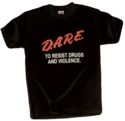Kravat


Kravat er et halsbind, færdigbundet slips eller andet klæde traditionelt båret af mænd til at binde om halsen, oftest dekorativt.[1] Kravatten kaldes undertiden også en ascot.
Se også
Referencer
Eksterne henvisninger
| Spire |
| ||||||||||||||||||||||||||||||||||||||||||||||||||||||||||||||||||||||
Medier brugt på denne side
D.A.R.E. T-shirt
An image showing some cravat-tying illustrations (engraved by George Cruikshank), and also partial descriptive text, taken from "Neckclothitania or Tietania, being an essay on Starchers, by One of the Cloth" (published by J.J. Stockdale, Sept. 1st. 1818).
This contains factual information, but is also a caricature of dandies who allegedly devoted exaggerated importance and great effort to the arrangement of their neckcloths. It contains some over-the-top facetious touches -- such as "Yeux de fille en extase" as the name of a color(!).
For more of the text of Neckclothitania, see Anne Woodley's site: http://homepages.ihug.co.nz/~awoodley/regency/tie.htmlForfatter/Opretter:


